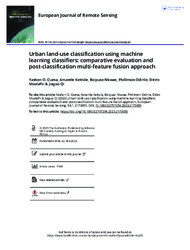Urban land-use classification using machine learning classifiers: comparative evaluation and post-classification multi-feature fusion approach.
Date
2023-02-22Author
Ouma, Yashon O
Keitsile, Amantle
Nkwae, Boipuso
Odirile, Phillimon
Moalafhi, Ditiro
Qi, Jiaguo
Metadata
Show full item recordAbstract
Accurate spatial-temporal mapping of urban land-use and land-cover (LULC) provides critical information for planning and management of urban environments. While several studies have investigated the significance of machine learning classifiers for urban land-use mapping, the determination of the optimal classifiers for the extraction of specific urban LULC classes in time and space is still a challenge especially for multitemporal and multisensor data sets. This study presents the results of urban LULC classification using decision tree-based classifiers comprising of gradient tree boosting (GTB), random forest (RF), in comparison with support vector machine (SVM) and multilayer perceptron neural networks (MLP-ANN). Using Landsat data from 1984 to 2020 at 5-year intervals for the Greater Gaborone Planning Area (GGPA) in Botswana, RF was the best classifier with overall average accuracy of 92.8%, MLP-ANN (91.2%), SVM (90.9%) and GTB (87.8%). To improve on the urban LULC mapping, the study presents a post-classification multiclass fusion of the best classifier results based on the principle of feature in-feature out (FEI-FEO) under mutual exclusivity boundary conditions. Through classifier ensemble, the FEI-FEO approach improved the overall LULC classification accuracy by more than 2% demonstrating the advantage of post-classification fusion in urban land-use mapping.
Collections
- Research articles [88]

